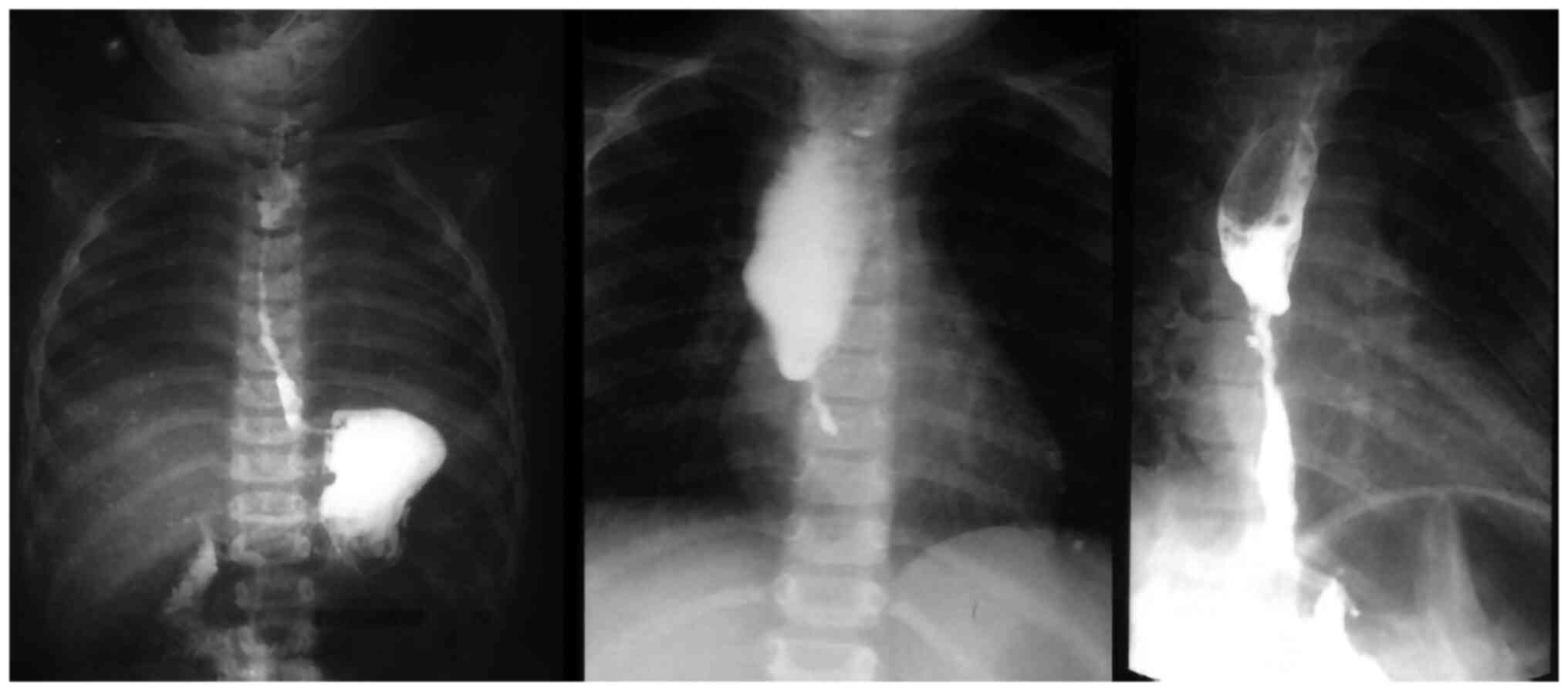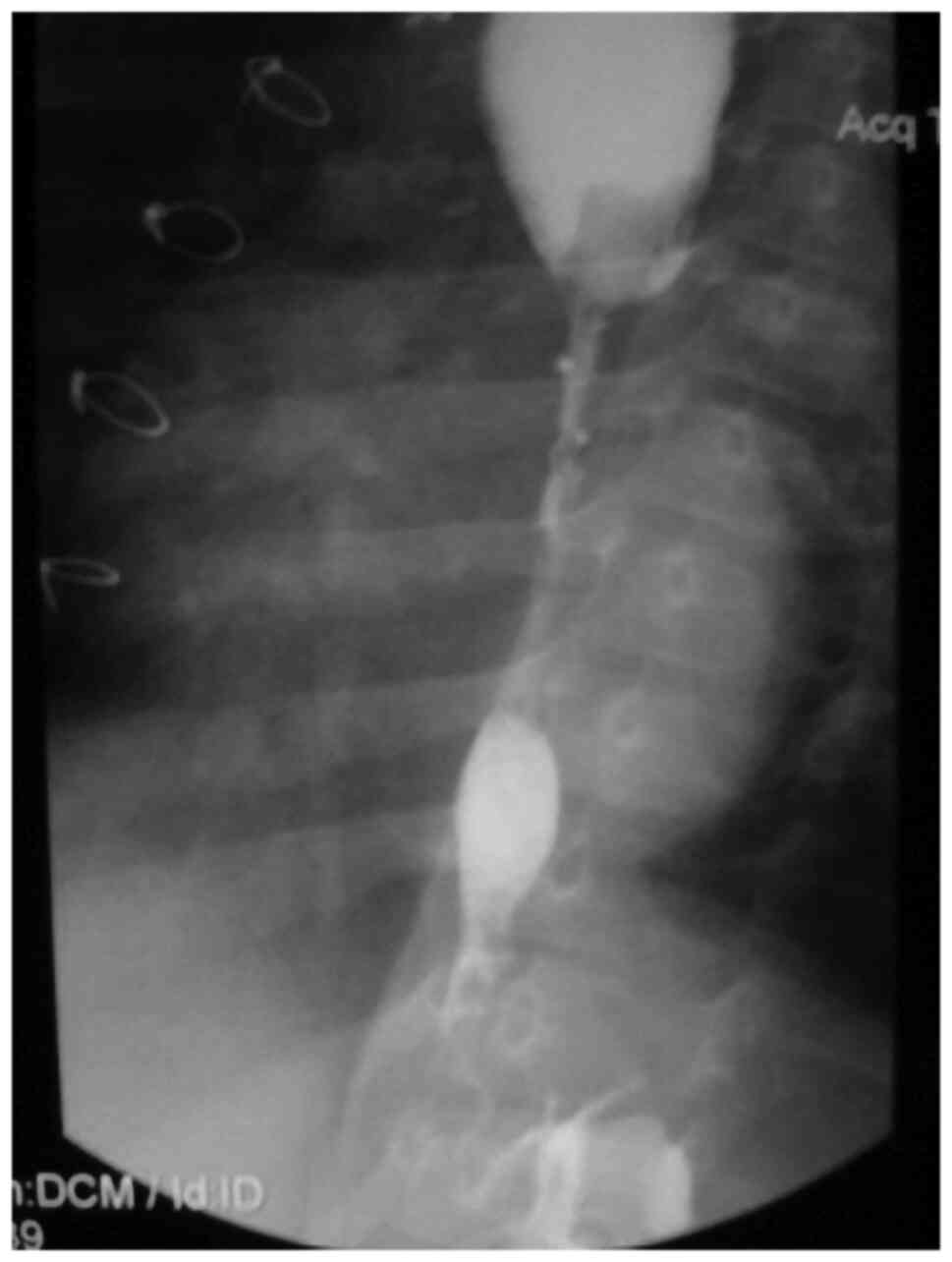|
1
|
Dodrill P and Gosa MM: Pediatric
dysphagis: Physiology, assessment, and management. Ann Nutr Metab.
66 (Suppl 5):S24–S31. 2015.PubMed/NCBI View Article : Google Scholar
|
|
2
|
Vandenplas Y: Management of benign
esophageal strictures in children. Pediatr Gastroenterol Hepatol
Nutr. 20:211–215. 2017.PubMed/NCBI View Article : Google Scholar
|
|
3
|
Spitz L: Oesophagealatresia. Orphanet J
Rare Dis. 2(24)2007.
|
|
4
|
Cloud DT: Anastomotic technic in
esophageal atresia. J Ped Surg. 3:561–564. 1968.PubMed/NCBI View Article : Google Scholar
|
|
5
|
D'Urzo C, Bunuomo V, Rando G and Pintus C:
Major anastomotic dehiscence after repair of esophageal atresia:
Conservative management or reoperation? Dis Esophagus. 18:120–123.
2005.PubMed/NCBI View Article : Google Scholar
|
|
6
|
Gupta M, Mahajan JK, Bawa M and Rao KLN:
Esophageal atresia and tracheoesophageal fistula: Effect of pleural
cover on anastomotic dehiscence. J Indian Assoc Pediatr Surg.
16:50–53. 2011.PubMed/NCBI View Article : Google Scholar
|
|
7
|
Spitz L, Kiely EM, Morecroft JA and Drake
DP: Oesophageal atresia: At-risk groups for the 1990s. J Ped Surg.
29:723–725. 1994.PubMed/NCBI View Article : Google Scholar
|
|
8
|
Okamoto T, Takamizawa S, Arai H, Bitoh Y,
Nakao M, Yokoi A and Nishijima E: Esophageal atresia: Prognostic
classification revisited. Surgery. 145:675–681. 2009.PubMed/NCBI View Article : Google Scholar
|
|
9
|
Puri P, O'Donnell B and Guiney EJ: Delayed
primary anastomosis following spontaneous growth of esophageal
segments in esophageal atresia. J Ped Surg. 16:180–183.
1981.PubMed/NCBI View Article : Google Scholar
|
|
10
|
Puri P, Ninan GK, Blake NS, Fitzgerald RJ,
Guiney EJ and O'Donnell B: Delayed primary anastomosis for
esophageal atresia: 18 Months' to 11 years' follow-up. J Pediatr
Surg. 27:1127–1130. 1992.PubMed/NCBI View Article : Google Scholar
|
|
11
|
Kelly JP, Shackelford GD and Roper CL:
Esophageal replacement with colon in children: Functional results
and long-term growth. Ann Thorac Surg. 36:634–643. 1983.PubMed/NCBI View Article : Google Scholar
|
|
12
|
Sri Paran T, Decaluwe D, Corbally M and
Puri M: Long-term results of delayed primary anastomosis for pure
oesophageal atresia: A 27-year follow up. Pediatr Surg Int.
23:647–651. 2007.PubMed/NCBI View Article : Google Scholar
|
|
13
|
Nagaya M, Kato J, Niimi N, Tanaka S and
Iio K: Proposal of a novel method to evaluate anastomotic tension
in esophageal atresia with a distal tracheoesophageal fistula.
Pediatr Surg Int. 21:780–785. 2005.PubMed/NCBI View Article : Google Scholar
|
|
14
|
Mckinnon LJ and Koloske AM: Prediction and
prevention of anastomotic complications of esophageal atresia and
tracheoesophageal fistula. J Pediatr Surg. 25:778–781.
1990.PubMed/NCBI View Article : Google Scholar
|
|
15
|
Upadhyaya VD, Gangopadhyaya AN, Gupta DK,
Sharma SP, Kumar V, Pandey A and Updhyaya AD: Prognosis of
congenital tracheoesophageal fistula with esophageal atresia on the
basis of gap length. Pediatr Surg Int. 23:767–771. 2007.PubMed/NCBI View Article : Google Scholar
|
|
16
|
Chittmittrapap S, Spitz L, Kiely EM and
Brereton RJ: Anastomotic leakage following surgery for esophageal
atresia. J Pediatr Surg. 27:29–32. 1992.PubMed/NCBI View Article : Google Scholar
|
|
17
|
Spataru RI, Popoiu MC and Ivanov M:
Foregut duplication cyst associated with esophageal
atresia-one-stage neonatal surgical repair. Indian J Surg. 77
(Suppl 1):S52–S55. 2015.PubMed/NCBI View Article : Google Scholar
|
|
18
|
Teimourian A, Donoso F, Stenström P,
Arnadottir H, Arnbjörnsson E, Lilja H and Salö M: Gender and birth
weight as risk factors for anastomotic stricture after esophageal
atresia repair: A systematic review and meta-analysis. BMC Pediatr.
20(400)2020.PubMed/NCBI View Article : Google Scholar
|
|
19
|
Dingemann C, Brendel J, Wenskus J, Pirr S,
Schukfeh N and Reinshagen K: Low gestational age is associated with
less anastomotic complications after open primary repair of
esophageal atresia with tracheoesophageal fistula. BMC Pediatr.
20(267)2020.PubMed/NCBI View Article : Google Scholar
|
|
20
|
Laberge JM and Blair GK: Thoracotomy for
repair of esophageal atresia: Not as bad as they want you to think!
Dis Esophagus. 26:365–371. 2013.PubMed/NCBI View Article : Google Scholar
|
|
21
|
Spitz L and Pierro A: Operative Pediatric
Surgery. Spitz L and Coran A (eds). CRC Press, Inc., Boca Raton, FL
pp135, 2013.
|
|
22
|
Takamizawa S, Tsugawa C, Naruaki M, Satoh
S, Kanegawa K, Nishijuma E and Muraji T: Congenital esophageal
stenosis: Therapeutic strategy based on etiology. J Pediatr Surg.
37:197–201. 2002.PubMed/NCBI View Article : Google Scholar
|
|
23
|
Kelly K, Storey L, O'Sullivan M, Butler K,
McDermott M, Corbally M, McMahon C, Smith OP and O'Marcaigh A:
Esophageal strictures during treatment for acute lymphoblastic
leukemia. J Pediatr Hematol Oncol. 32:124–127. 2010.PubMed/NCBI View Article : Google Scholar
|
|
24
|
Harmon CM and Coran AG: Congenital
anomalies of the esophagus. In: Pediatric Surgery. Coran AG, Adzick
NS, Krummel TM, Laberge J, Shamberger RC and Caldmone AA (eds). 7th
edition. Elsevier Saunders, Philadelphia, PH, pp893-918, 2012.
|
|
25
|
Suciu N, Serban A, Toader O, Oprescu D and
Spataru RI: Case report of fetal lingual tumor-perinatal care and
neonatal surgical intervention. J Matern Fetal Neonatal Med.
27:314–319. 2014.PubMed/NCBI View Article : Google Scholar
|
|
26
|
Spătaru RI, Iozsa DA and Ivanov M:
Preputial calculus in a neurologically-impaired child. Indian
Pediatr. 52:149–150. 2015.PubMed/NCBI View Article : Google Scholar
|
|
27
|
Pinheiro PF, Simões e Silva AC and Pereira
RM: Current knowledge on esophageal atresia. World J Gastroenterol.
18:362–372. 2012.PubMed/NCBI View Article : Google Scholar
|
|
28
|
Boia ES, Nicodin A, Popoiu MC, Trailescu M
and David VL: An effective method to release anastomotic tension
after repair of esophageal atresia using a Foley catheter.
Chirurgia (Bucur). 108:189–192. 2013.PubMed/NCBI
|
|
29
|
Tandon S, Burnand KM, De Coppi P, McLaren
CA, Roebuck DJ and Curry JI: Self-expanding esophageal stents for
the management of benign refractory esophageal strictures in
children: A systematic review and review of outcomes at a single
center. J Pediatr Surg. 54:2479–2486. 2019.PubMed/NCBI View Article : Google Scholar
|
|
30
|
Șerban D, Spătaru RI, Vancea G, Bălășescu
SA, Socea B, Tudor C and Dascălu AM: Informed consent in all
surgical specialties: From legal obligation to patient
satisfaction. Rom J Leg Med. 28:317–321. 2020.
|
|
31
|
Șerban D, Smarandache AM, Cristian D,
Tudor C, Duta L and Dascălu AM: Medical errors and patient safety
culture-shifting the healthcare paradigm in Romanian hospitals. Rom
J Leg Med. 28:195–201. 2020.
|



















